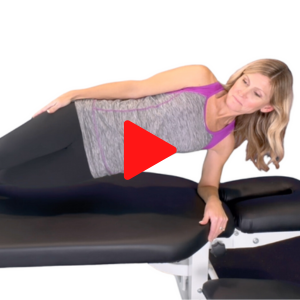Understanding Gluteal Tendinopathy: A Guide for Chiropractors
Pain on the outside of the hip is often misattributed to irritation of the greater trochanteric bursa. However, research indicates that gluteal tendinopathy is the more likely culprit. In fact, some studies suggest that not everyone even has a bursa—awkward, right? (1)
Anatomy and Mechanics: Why the Gluteal Tendon is Susceptible
The gluteal tendons are highly susceptible to compressive loads, partly due to the biomechanics of the femoroacetabular joint. For instance, the average femoral neck angle is 128º. A reduction of just 13º can increase compressive loads by a staggering 50%. Similarly, increased pelvic width has been linked to higher compressive forces on the tendon, further exacerbating its vulnerability. (2)
Identifying Painful Movements
For individuals with gluteal tendinopathy, pain is typically provoked by movements or positions that increase compressive loads on the tendon. Common triggers include:
Sleeping on the side
Sitting with legs crossed
Walking or running
Early Gluteal Tendinopathy Management: Reducing Compression
The initial goal in managing gluteal tendinopathy is to calm the tendon by minimizing provocative activities. Chiropractors can recommend the following strategies:
Sit with knees and hips aligned, avoiding crossed legs.
Sleep with a pillow between the knees or, if tolerated, switch to a supine position.
Modify activities to reduce unnecessary compression on the tendon.
For a helpful resource to share with patients, ChiroUp subscribers can access the Healthy Sleep Positions infographic in the Forms Library.
Gluteal Tendinopathy Exercises for Strengthening and Recovery
A progressive strengthening program is the cornerstone of treatment for gluteal tendinopathy. Here’s a step-by-step approach.
1. Start with Isometric Exercises
These are ideal for irritated tendons that don’t tolerate much load. For example, a side plank held for 30 seconds effectively loads the hip while minimizing adduction.
2. Progress to Concentric-Eccentric Exercises
The focus here is on slow, controlled movements (6-8 seconds per repetition) to optimize tendon adaptation. Examples include:
3. Incorporate Plyometric Exercises
These are essential for advanced rehab. Lateral hops—using either both legs or one leg, or skater jumps—are effective options. Remember, tendons require 72 hours to recover after plyometric loading.
Key Considerations for Tendon Recovery
Tendons adapt slowly to load, so a minimum 12-week rehab program is recommended—even if the pain subsides earlier. This ensures the tendon has ample time to strengthen and adapt.
Addressing Running Mechanics
There’s a common misconception that excessive hip adduction during running is solely a glute strength issue. However, studies suggest glute strength is not directly linked to this movement pattern. (3)
For runners returning to activity after rehab, this poses a challenge: although the tendon’s load tolerance has improved, running mechanics may still lead to increased compressive forces, potentially causing a relapse.
The Role of Running Cadence
Adjusting running cadence can significantly reduce compressive loads during a return-to-running program. When step rate is reduced, it increases ground contact time, which in turn leads to greater hip adduction and internal rotation. Both of these factors amplify compressive forces.
Ironically, running slower is often a common strategy after rehab, but this can unintentionally worsen the issue. To mitigate these effects, chiropractors can advise patients to increase their cadence by 10-20% compared to pre-injury levels. If the previous step rates are unknown, a good baseline to aim for is 170-180 steps per minute.
For a useful resource to guide patients, ChiroUp subscribers can access the Running Mechanics infographic in the Forms Library.
By understanding the biomechanics of gluteal tendinopathy and following an evidence-based rehab progression, chiropractors can empower their patients to recover effectively while minimizing the risk of re-injury.
Keep Patients Moving Forward with Confidence
Helping patients overcome gluteal tendinopathy requires the right combination of clinical precision and patient education. ChiroUp simplifies the process by providing evidence-based treatment protocols, exercise guidance, and patient-friendly resources—all designed to support better, faster outcomes.
Join thousands of chiropractors who trust ChiroUp.
No credit card is required.
-
Kong A, Van der Vliet A, Zadow S. MRI and US of gluteal tendinopathy in greater trochanteric pain syndrome. European radiology. 2007 Jul;17(7):1772-83.
Grimaldi A, Mellor R, Hodges P, Bennell K, Wajswelner H, Vicenzino B. Gluteal tendinopathy: a review of mechanisms, assessment and management. Sports Medicine. 2015 Aug;45:1107-19.
Willy RW, Davis IS. The effect of a hip-strengthening program on mechanics during running and during a single-leg squat. Journal of orthopaedic & sports physical therapy. 2011 Sep;41(9):625-32.







